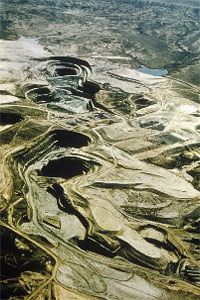Mining: Making the Most of Radioactive Caches
After locating uranium deposits and obtaining appropriate permits, a company will begin to mine. There are a few ways to extract uranium from the ground: open-pit mining, underground mining and in-situ recovery.
Mining methods depend on the type of deposit, whether it's suspended in water and the geography of the area. For instance, if miners find a deposit sandwiched between layers of rock and water, in-situ recovery will be a more cost-effective option. If experts deal with dry ore, they'll most likely stick with a type of open-pit or underground mining.
Advertisement
- Open-pit removal for uranium closely resembles what's done to mine other metal ore. Experts and miners will use machines and explosives to create a pit. Then, they'll remove the uranium ore in chunks to be transported for further processing. Miners are specially trained to separate ore from waste. Often, they keep this motto in mind: "A mine is a terrible thing to waste, and waste is a terrible thing to mine" [source: Hunter]. Open-pit differs from other types of surface mining, which remove topsoil in strips throughout the mining process.
- Underground mining calls for venturing deeper into underground mine systems, where miners use shafts or adits (vertical and horizontal tunnels) to move equipment and position workers throughout the mine. As we'll discuss later, mining underground for uranium poses higher health risks than other methods.
- In-situ recovery (previously called in-situ leaching) remains a popular way to mine for uranium, especially in the United States, where uranium deposits often lie between rock and aquifers. Rather than removing chunks of ore for processing, in-situ recovery requires using chemistry to separate the uranium from ore in the ground. By injecting baking soda and club-soda-like solutions into the ore through pipes, miners separate uranium from the rock and pump the solution to the surface. In the United States, this is the most common form of uranium mining for sandstone deposits [source: EPA]. Experts say in-situ recovery leaves a smaller footprint on the environment, as well as a smaller reclamation tab for mining companies [sources: Deery; Hunter].
- Some operations use heap leaching, a process by which companies extract ore, break it into smaller pieces above ground and leach the pile with chemicals to separate the uranium. As the chemicals soak in, the uranium leaches into underground pipes that gather the solution. American uranium mines do not practice this method, mostly because of the environmental impacts of using acidic chemicals.
Uranium mines might appear expansive, but a relatively small number of workers perform duties at each site. Roughly 35 people help drill and place steel reinforcements into the ground to secure shafts with machines, 35 miners specialize in removing the uranium ore (in open-pit operations; 20 for underground) and about 25 individuals assist with the reclamation process in efforts to restore land back to its natural state [source: Deery].
Head over to the following page to find out how a slushy mixture of rock and uranium becomes nuclear fuel.
